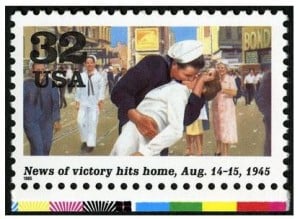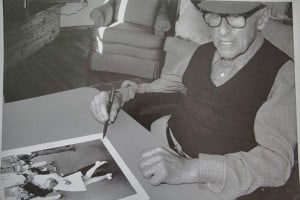There is a 32 cent stamp depicting the moment the news of Japan’s surrender hits the U.S. – most people recognize the image of a sailor kissing a nurse in Times Square on VJ Day, August 14, 1945. What was surprising to me when I began looking for a image of it to share that is in the public domain I found that there were actually TWO different photos that had both captured that famous embrace which Life magazine had this caption: “In New York’s Times Square a white-clad girl clutches her purse and skirt as an uninhibited sailor plants his lips squarely on hers.”
One photo was taken by a navy photo journalist, Victor Jorgensen, and the other by Alfred Eisenstaedt. Perhaps you already knew all this about having two photos taken simultaneously that captured the same moment of V-J Day embrace ? I had not realized it.

In further looking around there is probably enough information with links and stories to research for a semester on different aspects (which I will share a few of those links.) What was interesting was to see there were two different photos taken and there was all kind of curiosity over the years about just who it was that actually IS IN the photo.
Attribution: The image upper left was taken by Lt. Victor Jorgensen (US archives) [Public domain], via Wikimedia Commons. Taken on August 14, 1945. “New York City celebrating the surrender of Japan. They threw anything and kissed anybody in Times Square.” National archive number 80-G-377094. Naval Historical Center #520697. File: Kissing the War Goodbye.jpg
The two photographers of V J Day celebration:
In looking around Wikipedia had great summations on each of them that I wanted to share their intro’s:
“Victor Jorgensen (July 8, 1913 – June 14, 1994) was a former Navy photo journalist who probably is most notable for taking an instantly iconic photograph of an impromptu scene in Manhattan on August 14, 1945, but from a different angle and in a less dramatic exposure than that of a photograph taken by Alfred Eisenstaedt. Both photographs were of the same V-J Day embrace of a woman in a white dress by a sailor. Eisenstaedt’s better known photograph, V-J Day in Times Square was published in Life. On the day after the images were taken by the two photographers, the one taken by Jorgensen was published in The New York Times. His photograph, which was taken while he was on duty, is retained in the National Archives and Records Administration.” Thank you to Wikipedia (On Twitter @Wikipedia).

“Alfred Eisenstaedt (December 6, 1898 – August 23, 1995) was a German-born American photographer and photojournalist. One of the most prolific photographers of the twentieth century, he began his career in pre-World War II Germany, and after moving to the U.S., achieved prominence as a staff photographer for Life Magazine which featured more than 90 of his pictures on its covers with over 2,500 photo stories published. Among his most famous cover photographs was the V-J Day celebration in New York City of “an exuberant American sailor kissing a nurse in a dancelike dip [that] summed up the euphoria many Americans felt as the war came to a close.” Eisenstaedt was “renowned for his ability to capture memorable images of important people in the news, including statesmen, movie stars and artists” and for his candid photographs, taken with a small35mm Leica camera and typically with only natural lighting.“”
The “Who” & “When” of the moment captured
If you think back 70 years ago there was no electronic ‘tagging’ of who is in a photograph like we can do today.
There is this book: “The Kissing Sailor: The Mystery Behind the Photo that Ended World War II” Hardcover – May 15, 2012 by Authors Lawrence Verria, and Captain George Galdorisi, USN (Ret.), with a Foreword by David Hartman. One review on Amazon said “The authors not only do a great job in following the clues that led to the undisputable claim that Mendonsa and Zimmer are, in fact, the kissing couple, but they also convey the euphoria that swept the country when the war ended.” — WWII History, July 2012″
In her recent July 5, 2015 LA Times article “Astronomical sleuth reveals the timing of the iconic 1945 ‘Kiss’” by Deborah Netburn (On Twitter @DeborahNetburn) it talks about a professor of physics and astronomy is leading a group to scientifically determine what time the photo was taken. “It’s an iconic image: A sailor kisses a nurse in Times Square after hearing the news that World War II was officially over — just after 7 p.m. on August 14, 1945. Or maybe not. Some skeptics are now challenging that widely accepted story. In their version of events, the famous kiss captured by Life magazine photographer Alfred Eisenstaedt may have occurred more than an hour before the official announcement that the war had ended….” and includes “With that clue in hand, he was able to use spherical trigonometry and projective geometry to calculate where in the sky the sun had to be for the sign to cast the exact shadow depicted in the photograph.”
So which of the two photos is the stamp based on?
From this article from June 24, 2010 An Iconic Image & Kiss Recalled at the Smithsonian’s National Postal Museum Blog. (On Twitter @PostalMuseum):
“When designing a stamp to commemorate VJ Day, Eisenstaedt’s photo won the honor of being featured, as everyone agreed that it depicts the celebratory nature of the end of World War II.”
Some ironies:
From August 15, 2013 by William Porter: “A Tale of Two Kisses: Eisenstaedt in New York, Doisneau in Paris” within the details of his article on comparing and contrasting Alfred Eisenstaedt’s photo of the sailor kissing the “nurse” in Times Square on VJ Day (1945), and Robert Doisneau’s photo of the couple kissing near City Hall in Paris” he includes some ironies in talking about the VJ Day photo:
“There are several ironies. The couple were indeed strangers, as the photo suggests and as everybody always assumed. What’s not been known (certainly not to me) is that the sailor was on a first date with the girl he eventually married, and his future wife is in the photo, about 10 feet behind him (over his shoulder). Another small irony is that the sailor – who had seen combat in the Pacific and seen nurses at work – kissed the girl, not because she was the first pretty girl he saw, but because he thought she was a nurse. But she wasn’t. She was a dentist’s assistant”. He further goes onto refer to the same book that I listed above: “For more, you can read the somewhat hyperbolically titled book, “The Kissing Sailor: The Mystery Behind the Photo that Ended World War II.“
So there we have it. The next time you are in a restaurant and see that image on a framed poster on the wall or come across that stamp in your stamp collection you can smile knowing we paused today to really look at the image and found out more about it. And just think, who knows, sometime – somewhere – your image could get included in a historic scene for the whole world to want to embrace and remember for years to come – and because of our technology – it would not take years to figure out it is you! So remember that the next time you are tempted to make a dash to “run to the store and no one will see me!” – at least clean up a little!
Join me tomorrow for our Saturday blog post as we enjoy the weekend – and yes, college sweatshirt and casual attire welcomed!
![]() Anchors Aweigh,
Anchors Aweigh,
Helen




